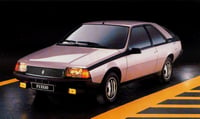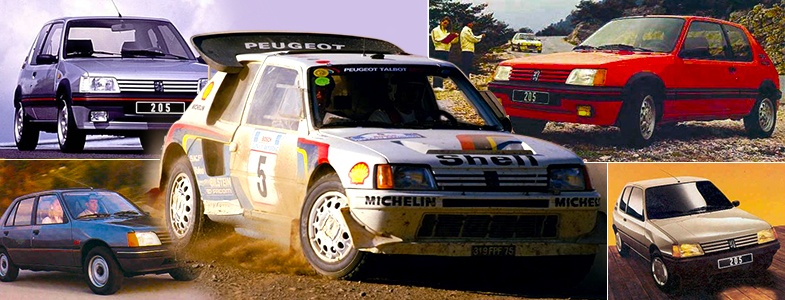
Peugeot got the 205 so right and their reward was 5 million sales.
No one can contest that the Peugeot 205 isn’t an important part of automotive history, it was packed with style and was underpinned with up to date technology when it was launched in the early 1980’s; it was the new benchmark for the supermini sector.
The 205 was a bit of a turning point for Peugeot and a fundamental car, it had been in financial trouble after the Chrysler Europe take over in the late 1970’s. Up until the 205 Peugeot had mainly been a family car manufacturer, although it had produced some stylish coupe and convertible models over the years. The 205 transformed Peugeot into a vogue brand and gave it something to draw on over the following decades. The 205’s predecessor the 104 had reasonable success but it certainly didn’t have the style of the 205.
The 205 project commenced in 1977 with the car ready for market in the spring of 1983.The design was purely in-house, although there was competition with the in-house designer and external design company Pininfarina. Some of the later variants were outsourced to Pininfarina, such as the convertible known as the CJ. The 205 was in fact a stark contrast to the 104 it replaced, the 104 was very bland in the styling stakes.
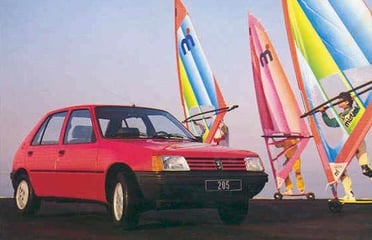 The starting point for the 205 was that it had to be able to accommodate 5 people along with decent luggage space too but still be compact at between 3.6 and 3.8 metres in length. The 205 had what would become the new family look front end with the Lion taking its position in the middle of the 3 bar colour coded grill. It was launched as a 5 door with the 3 door being added a year later. The 5 door had perfect proportions with slender A and B pillars giving a large glass area and the flaired C pillar leading to the slightly stubby but perfectly proportioned back end with very little rear overhang. The rear lights were right at the corners with a trim panel between them.
The starting point for the 205 was that it had to be able to accommodate 5 people along with decent luggage space too but still be compact at between 3.6 and 3.8 metres in length. The 205 had what would become the new family look front end with the Lion taking its position in the middle of the 3 bar colour coded grill. It was launched as a 5 door with the 3 door being added a year later. The 5 door had perfect proportions with slender A and B pillars giving a large glass area and the flaired C pillar leading to the slightly stubby but perfectly proportioned back end with very little rear overhang. The rear lights were right at the corners with a trim panel between them.
Often the 5 door version of a supermini can be a compromise in looks but this wasn’t the case with the 205, the 5 door looked good from every angle. The 3 door was even better especially in GTi trim level with the larger rims and wheel arch extensions, you just knew it was going to handle extremely well. The wheels were out at the corners with minimal overhang and it just sat so well. It has to be said that there was very little to criticise the 205 design on.
The 205 quickly became the new benchmark for the supermini sector, it made its competitors look so dated. Its French rival the Renault 5 was totally out of step, but it was getting on a bit when the 205 was launched. Ford’s Fiesta was just about to go to the Mk2 but even this was no match for the 205. Vauxhall had the recently launched but equally as uninspiring Nova. Citroen’s offering, Peugeot’s sister company, was the quirky Visa; this was pure Citroen and only appealed to manufacturer’s loyal fan base. The 205 left its competitors well and truly in its dust.
The 205 had a pretty good suspension for a French car, as historically the French favoured a soft suspension set up with very little body roll control. The 205 had McPherson struts at the front and a pure torsion bar spring set up at the rear with no coil springs. This rear suspension construction was very compact and it meant that there was no intrusion of suspension components into the boot, which increased boot space. This set up was excellent when you got to the sporty models in the range and when combined with the “wheel at each corner” chassis, it was well balanced and precise.
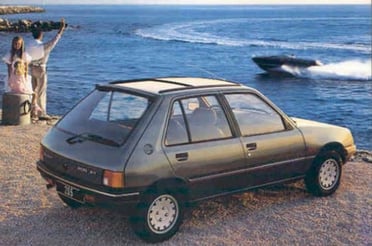 The power units were carried over from the 104 initially but then within a couple of years the new TU units were added, although they were just an evolution of the X series they replaced. Peugeot had already gone full alloy and overhead camshaft 10 years earlier. But the interesting part was the fact that Peugeot slipped a diesel unit in to the 205, one of the very earliest supermini diesels. This was the recently introduced 1769 cc XUD. This was a highly acclaimed unit due to its power and refinement, of course it wasn’t that refined by today’s standards but this was a time when diesel was reserved for heavy goods vehicles and taxis in the main.
The power units were carried over from the 104 initially but then within a couple of years the new TU units were added, although they were just an evolution of the X series they replaced. Peugeot had already gone full alloy and overhead camshaft 10 years earlier. But the interesting part was the fact that Peugeot slipped a diesel unit in to the 205, one of the very earliest supermini diesels. This was the recently introduced 1769 cc XUD. This was a highly acclaimed unit due to its power and refinement, of course it wasn’t that refined by today’s standards but this was a time when diesel was reserved for heavy goods vehicles and taxis in the main.
The key sellers were the 954 and 1124 cc petrol units with 45 and 50 ps respectively but there was also a 1360 cc petrol unit with 60 ps. The 1.1 and the 1.4 came with 5 speed gearbox as opposed to the 4 speed that was standard on the 1.0. Adding in a 5 speed gearbox was another sector leading move by Peugeot. The diesel 1.8 had 59 ps and of course this application needed a 5 speed gearbox to keep the diesel engine in the right rev range when cruising on the motorway.
Trim levels were plentiful, there was no name lead-in along with a E, L, R, GT. The prefix to the badge was either X or G, so XE, XL, GL, GR and so on. The X was for 3 doors and the G was for 5 doors, a neat touch for the time that helped with vehicle identification. The lead-in 205 3 door was priced at £3,895 at launch.
It was the GTi that was the immediate halo model though. This was a hit from day one with its 105 ps fuel injected single overhead camshaft 1580 cc engine. It was quite a rev happy unit with peak power up at 6250 rpm and for the power its 0-62 time of 8.9 seconds was very acceptable, although the fact that it weighed in at 850 kg probably helped it a lot. Its top speed was also impressive at 120 mph. It was kitted out with 14 inch alloy wheels, a roof spoiler, front fog lights and wheel arch extensions; on the outside. On the inside it was very sporty indeed; there were sports seats, red carpets, a 3 spoke sports steering wheel, six dial dashboard with rev counter and also tinted windows.
Within a couple of years 105 ps just wasn’t enough power to keep up with the hot hatch movement and therefore Peugeot added their 1905 cc 130 ps power plant. This shortened the 0-62 time down to 7.6 seconds and increased the top speed to 123 mph. The specifications were very similar but the distinguishing feature was the alloy wheels, these were increased to 15 inch and were an 8 slot design that really suited the car as opposed to the multi hole 14 inch on the 1.6 and it also had half leather seats too. There was also the engine badge on the C pillar to help split the two. The 1.6 GTi was priced at £6,295 at introduction in the summer of 1984 and 1.9 was £9,295 in the autumn of 1986 when it was introduced.
Peugeot had one more card up its sleeve with the 205 though, the group B rally car; namely the T16. The T16 was a mid-engine 4 wheel drive pocket rocket. It was totally re-engineered and shared only a few panels with the standard car. Power came from 1.8 turbo charged 4 cylinder units that had the cast iron cylinder block from the diesel along with a specially developed 16 valve cylinder head.
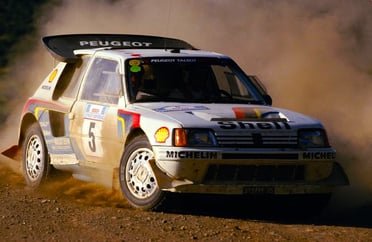 For the 200 homologation versions that were needed to take it rallying the standard state of tune was 200 ps and this was up at 6750 rpm, the rally version had 365 ps and later on an Evo version was added with 550 ps. The 0-62 sprint of the standard T16 was 6.4 seconds and the top speed was 129 mph. But it was its agility and precision that were probably the most important factor, it was a pleasure to watch rally track. It immediately rewarded Peugeot with driver and constructor wins in the 1985 and 1986 World Rally Championship. The drivers were Timo Salonen in 85 and Juha Kankkunen in 86. The T16 took the last Group B win as 1986 was the year that saw the end of the class of vehicle in the WRC.
For the 200 homologation versions that were needed to take it rallying the standard state of tune was 200 ps and this was up at 6750 rpm, the rally version had 365 ps and later on an Evo version was added with 550 ps. The 0-62 sprint of the standard T16 was 6.4 seconds and the top speed was 129 mph. But it was its agility and precision that were probably the most important factor, it was a pleasure to watch rally track. It immediately rewarded Peugeot with driver and constructor wins in the 1985 and 1986 World Rally Championship. The drivers were Timo Salonen in 85 and Juha Kankkunen in 86. The T16 took the last Group B win as 1986 was the year that saw the end of the class of vehicle in the WRC.
The 205 was on sale from 1983 to 1997 in the UK, although globally production carried on for another year or so to 1998. UK sales over its life were 425,204 with its peak year being 1988 when 54,147 were sold. It took over 2.0% of the market share every year from 1986 to 1992 with its peak being 1991 when it took 2.9% of the market. The 205 survival rate isn’t too bad with the usual period rust issues not being such a problem, meaning that there are over 10,000 still around in the UK. The GTi has the highest volume at over 2,500 left. Values of the GTi are on the up, as with most 80’s hot hatchbacks, especially one that was very popular at the time. The T16 is very special and has a very special price tag, as you would expect with a Group B legend.
The Good; Almost perfect design.
The Bad: Although the 206 was good it wasn’t quite as cutting edge as the 205.
The Ugly: Ari Vatanen’s near career ending crash in a T16.
Next month - Renault Fuego
